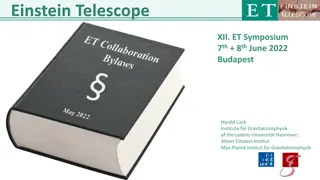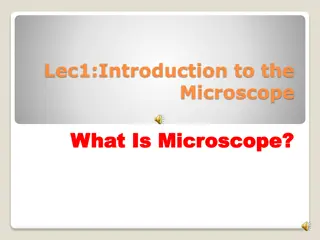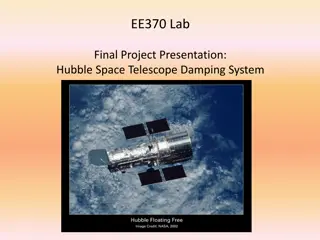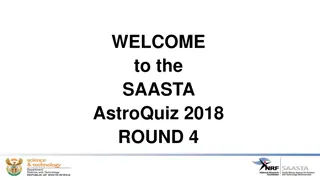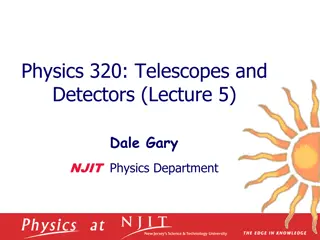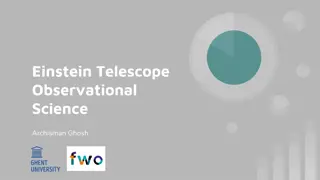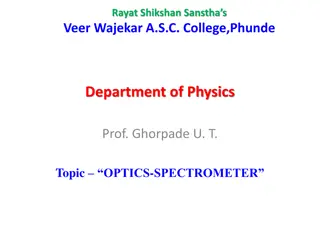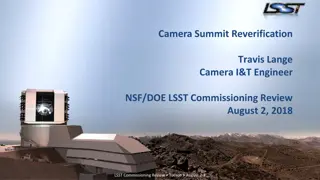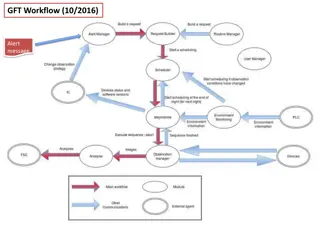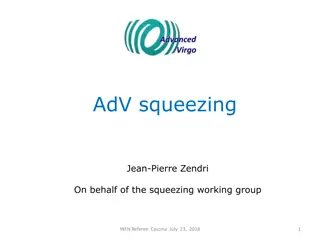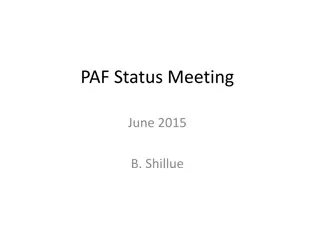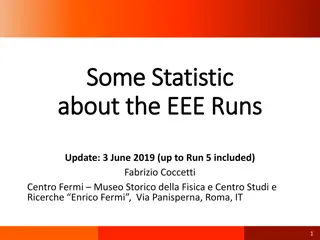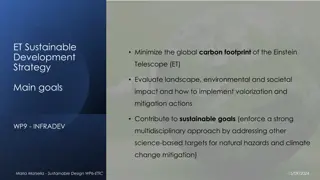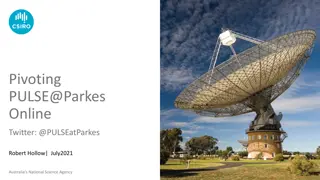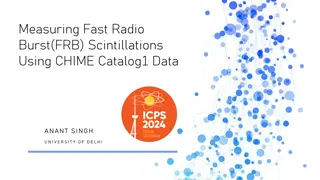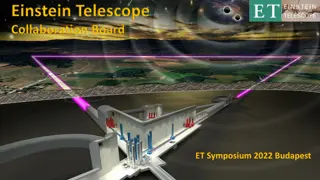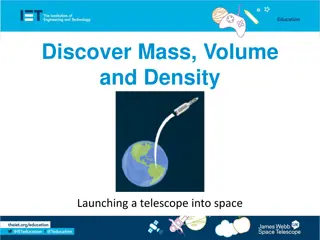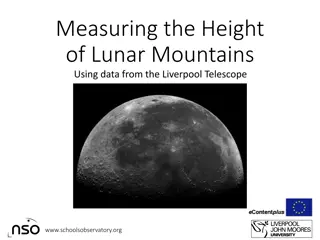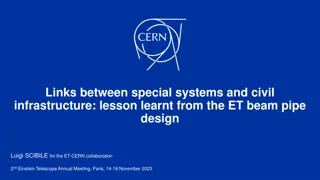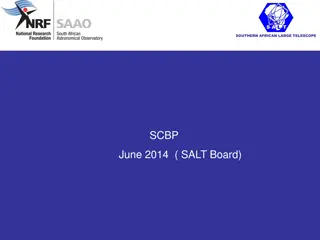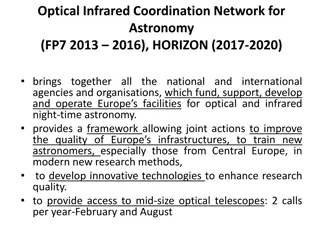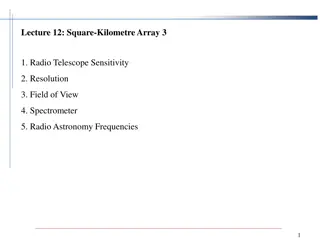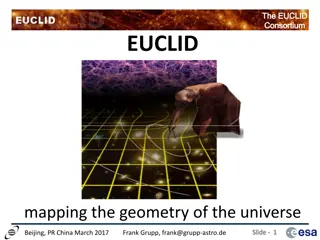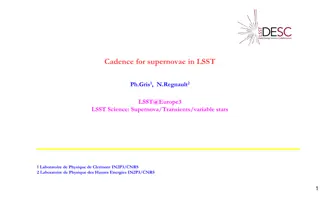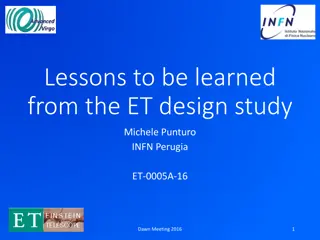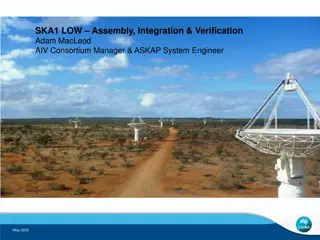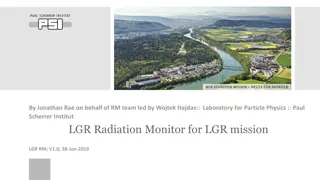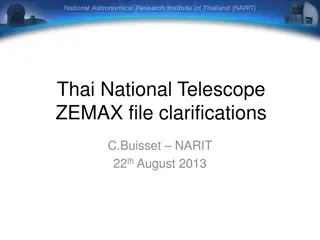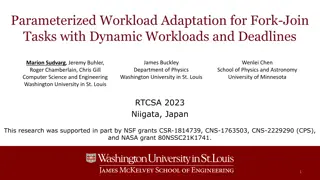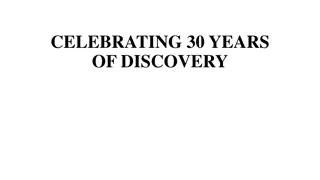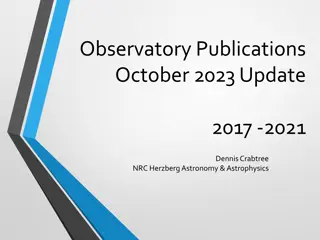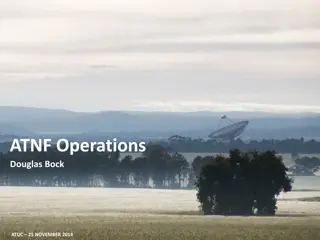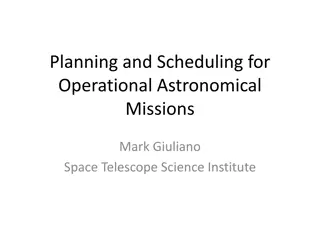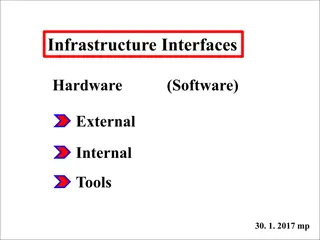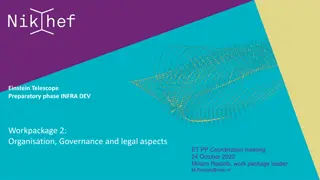get⚡[PDF]❤ The Hubble Space Telescope: From Concept to Success (Springer Praxis
\"COPY LINK HERE ; https:\/\/getpdf.readbooks.link\/B018JVROGY\n\n[READ DOWNLOAD] The Hubble Space Telescope: From Concept to Success (Springer Praxis Books) | The Hubble Space Telescope: From Concept to Success (Springer Praxis Books)\n\"\n
1 views • 6 slides
Hosting Matters Summary: Infrastructure Development and Governance Framework Update
Providing access to new assets and infrastructure, such as the Engineering Operations Centre and Science Operations Centre, is crucial for supporting the delivery and operation of the SKA MID telescope. The governance framework outlines key documents and obligations, including agreements with SKAO a
2 views • 13 slides
Einstein Telescope Collaboration Bylaws and Code of Conduct
The Einstein Telescope Collaboration has established internal rules and a Code of Conduct to ensure a professional, respectful, and inclusive environment free from discrimination and harassment. All members are expected to adhere to these guidelines to foster a supportive atmosphere for scientific d
1 views • 32 slides
Evolution of Microscopes: From Reading Stones to Phase-Contrast Microscopy
The history of microscopes dates back to the 11th century with the invention of the reading stone, leading to the creation of wearable eyeglasses in the 13th century. The first microscope was developed in the late 16th century by Zacharias Jansen, paving the way for the compound microscope and the t
0 views • 17 slides
Hubble Space Telescope Damping System for Oscillation Reduction
This presentation focuses on the design and implementation of a compensator system to reduce deleterious oscillations affecting observations from the Hubble Space Telescope. Utilizing MATLAB for frequency response analysis, the project aims to dampen oscillations occurring at distinct frequencies, e
0 views • 12 slides
SAASTA AstroQuiz 2018 Round 4 - Test Your Astrophysics Knowledge!
Challenge your knowledge of astronomy with these 10 questions from the SAASTA AstroQuiz 2018 Round 4. Test your understanding of telescopes, galaxies, planets, and more in this exciting quiz. Answer questions on various aspects of astronomy, from telescope construction in South Africa to planetary r
0 views • 44 slides
Optical Telescope Types and Lens-Maker's Formula
Optical telescopes utilize lenses or mirrors to collect and focus light for imaging celestial objects. The lens-maker's formula is crucial for determining the focal length of lenses, considering factors like index of refraction and radii of curvature. Different lens configurations and materials help
0 views • 17 slides
Einstein Telescope: Observational Science and Board Details
Delve into the world of observational science with the Einstein Telescope (ET). This comprehensive overview covers the involvement of Flanders researchers, gravitational wave sources, ET's detection capabilities, and its significant contributions to black hole and neutron star properties. Learn abou
1 views • 12 slides
Optics Spectrometer Setup at Rayat Shikshan Sanstha's Veer Wajekar A.S.C. College
Construction and setup guide for an optics spectrometer at Rayat Shikshan Sanstha's Veer Wajekar A.S.C. College, including details on the telescope, collimator, and prism table. Instructions cover aligning the telescope, setting up the collimator, and positioning the spectrometer table. Steps are pr
7 views • 10 slides
LSST Commissioning Review: Camera Summit Reverification and Hazards
In preparation for the LSST Commissioning Review in Tucson, the Camera Summit Reverification process led by Travis Lange, an I&T Engineer, involves re-assembling the camera and re-verifying requirements. The schedule, budget, risks, and hazards are outlined, including inherited risks from the I&T ph
1 views • 35 slides
ATST Safety Review High-Level Software Overview
This document provides an overview of the high-level software components involved in the ATST Safety Review conducted on 26th January 2011. It includes details on the Telescope Software Control Systems, Observatory Software Control Systems, and Instrument Software Control Systems, along with respons
13 views • 15 slides
Advanced Workflow Management System for Astronomical Observatories
Cutting-edge workflow system designed for effective planning, execution, and management of telescope data flows in astronomical observatories. The system includes modules for image acquisition, data processing, alert management, and real-time data analysis. It provides seamless integration and autom
0 views • 5 slides
Advanced Virgo Squeezing Working Group Overview
The Advanced Virgo (AdV) project involves various activities related to squeezing technology, optical layouts, Faraday isolators, and electronics. The project includes components like the squeezer, clean room, detectors, telescopes, and alignment systems. The installation, commissioning, and status
0 views • 34 slides
Progress Update on Phased Array Feeds Project - June 2015
In June 2015, progress was reported on the Phased Array Feeds project, highlighting successful tests at the Green Bank Telescope (GBT). The collaboration included advancements in beamforming technology, backend bandwidth expansion, and instrumentation upgrades. Despite some discrepancies between mod
0 views • 14 slides
EEE Runs Update: Statistics and Performance Summary as of June 3, 2019
Total tracks acquired, days of data taking, candidate tracks per day, performance metrics, and duty cycle information for the EEE telescope network up to Run 5, as reported by Fabrizio Coccetti at Centro Fermi Museo Storico della Fisica e Centro Studi e Ricerche Enrico Fermi in Rome, Italy. The netw
0 views • 16 slides
ET Sustainable Development Strategy: Minimizing Global Carbon Footprint
In the pursuit of sustainable development, the Einstein Telescope (ET) is focusing on minimizing its global carbon footprint. Maria Marsella leads the efforts to evaluate the environmental, societal, and landscape impacts of this strategy, aiming to implement valorization and mitigation actions. By
1 views • 8 slides
PULSE@Parkes: Engaging High School Students in Astronomy Education
PULSE@Parkes is a program where high school students collaborate with professional astronomers to conduct remote observations using the Parkes radio telescope. The program offers hands-on experiences, online modules, and data sessions for students in years 10-12. Students also have the opportunity t
0 views • 36 slides
Fast Radio Bursts (FRBs) and Scintillations in the Universe
Fast Radio Bursts (FRBs) are millisecond-duration bursts of radio waves originating from outside our galaxy, offering researchers a unique opportunity to investigate baryon distributions and probe the cold gas clumps in the Universe. Scintillations in radio waves caused by irregularities in the inte
1 views • 25 slides
Einstein Telescope Collaboration Board Symposium 2022 Budapest Agenda and Special Guests
The Einstein Telescope Collaboration Board Symposium 2022 in Budapest covers various agenda items including membership, elections, discussions on boards, and updating Bylaws. Special guests from ET Directorate and other collaborations are attending. The Collaboration Board is the governing body maki
0 views • 26 slides
Mass, Volume, and Density in Space Telescope Launch
Delve into the world of mass, volume, and density as we prepare to launch a telescope into space. Discover the importance of understanding these concepts in selecting materials for space exploration and learn about measuring mass, volume, and density through engaging activities.
0 views • 11 slides
Estimating Lunar Mountain Heights with Shadow Lengths
Explore how to estimate the height of lunar mountains by measuring the length of their shadows on the Moon's surface using data from the Liverpool Telescope. Discover the intriguing world of lunar shadows and how they can reveal information about celestial features. See how similar triangles and geo
0 views • 14 slides
Lessons Learned from ET Beam Pipe Design for Infrastructure Linkages
Understanding the interfaces between the ET beam pipe and civil infrastructure is vital for successful project implementation. Luigi Scibile shares insights on the connections with roads, buildings, shafts, tunnels, and more at the 2nd Einstein Telescope Annual Meeting in Paris, November 2023. The p
0 views • 12 slides
Southern African Large Telescope Report Summary
The report highlights the achievements and initiatives of the Southern African Large Telescope (SALT) project in 2013/14, including outreach statistics, successes with SALT partners, future programs, and suggestions. It covers various activities such as exhibitions, teacher training, robotic telesco
0 views • 5 slides
Optical Infrared Coordination Network for Astronomy (FP7 2013-2016), HORIZON (2017-2020)
This network consolidates funding and support for Europe's optical and infrared astronomy facilities, aiming to enhance infrastructure, train new astronomers, and develop cutting-edge technologies. It emphasizes collaboration among national and international agencies, optimizing access to mid-size t
0 views • 20 slides
Radio Telescope Sensitivity and Resolution in Radio Astronomy
This lecture covers the concepts of radio telescope sensitivity in detecting small temperature variations from the sky, including factors such as radiometric sensitivity, antenna noise temperature, receiver system noise, and more. Additionally, it touches upon the resolution capabilities of radio te
0 views • 22 slides
The EUCLID Consortium - Mapping the Geometry of the Universe
The EUCLID Consortium presented their mission at a conference in Beijing, PR China in March 2017. The consortium outlined the science case, mission requirements, technical challenges, and detailed plans for their telescope, focusing on galaxy shape measurement, redshifts, spectroscopy, and photometr
0 views • 26 slides
Cadence for Supernovae in LSST and Dark Energy Hubble Diagrams
This content discusses the cadence for supernovae observations in the Large Synoptic Survey Telescope (LSST) and presents Hubble diagrams related to Supernovae and Dark Energy research. The images and descriptions focus on cosmological aspects, distance moduli, observational strategies, and constrai
0 views • 21 slides
Lessons Learned from the Einstein Telescope Design Study
The design study of the Einstein Telescope (ET) provides valuable insights into the evolution of 3G detector concepts, the crucial role of networking structures, and the key elements of the ET Research Infrastructure. Lessons from failures, explorations, and refinements have shaped the development o
0 views • 14 slides
SKA1 Low Assembly Integration & Verification Plan
The SKA1 Low Assembly, Integration, and Verification (AIV) Plan outlines the responsibilities of the AIV Consortium, consortium partners, and the roll-out plan for the SKA1 Low telescope. The plan encompasses user requirements validation, system verification, operational concepts, and more. It detai
0 views • 12 slides
Science Community Engagement and ATST Development Summary
Science community engagement and development of the Advanced Technology Solar Telescope (ATST) are critical for the success of the project. The formation of core groups, hosting ATST science meetings, and involving a wider US user community are key recommendations from reports and discussions. The P
0 views • 13 slides
Advances in Radiation Monitoring Technology for Space Missions
Cutting-edge radiation monitoring technology developed by Jonathan Rae and the team at the Laboratory for Particle Physics, Paul Scherrer Institut, aims to provide in-situ measurements of protons, electrons, and ions for space missions. The LGR Radiation Monitor (RM) features improved detection tech
0 views • 8 slides
Insights into NARIT ULTRASPEC TNT ZEMAX Files for Thai National Telescope - July 2013
Explore detailed information about the NARIT ULTRASPEC TNT ZEMAX files related to the Thai National Telescope in July 2013. Dive into the optical surfaces, interface planes, and mechanical distances within the telescope system. The content includes images and descriptions validating the ZEMAX model'
0 views • 10 slides
Parameterized Workload Adaptation for Fork-Join Tasks with Dynamic Workloads and Deadlines
In dynamic environments, tasks may face unknown workloads and deadlines, leading to system overload and missed deadlines. This research focuses on adapting task workloads to provide results before the deadline by adjusting computational parameters. It explores how to minimize degradation of result u
0 views • 31 slides
Celebrating 30 Years of Discovery with the Hubble Space Telescope
On April 24, 1990, the space shuttle Discovery launched the Hubble Space Telescope into space, marking the beginning of an incredible journey of discovery. Over the past 30 years, Hubble has revolutionized our understanding of the universe, from exploring galaxies and black holes to revealing the my
0 views • 5 slides
Telescope Productivity and Impact Analysis 2017-2021
This update analyzes telescope productivity and impact in the field of Astronomy and Astrophysics from 2017 to 2021. It includes data on publications, citations, productivity per telescope, and impact of papers. Insights on high impact papers and inequality in impact distribution are also discussed
0 views • 19 slides
Highlights from ATNF Operations Meeting - November 25, 2014
Insights from the ATNF Operations meeting held on November 25, 2014, covering topics such as budget implications, telescope availability, Parkes and ATCA updates, LBA and Tidbinbilla operations, Mopra telescope status, user support, and qualification. The meeting discussed changes in visitor service
0 views • 16 slides
Astronomical Planning and Scheduling for Scientific Missions
Explore the operational aspects of astronomical missions led by the Space Telescope Science Institute, covering the Hubble Space Telescope and the upcoming James Webb Space Telescope. Learn about the goals, features, constraints, and use cases of planning and scheduling, along with mission character
0 views • 43 slides
Enhancing Infrastructure Interfaces for Telescope Operations
In the realm of telescope operations, ensuring clear interfaces is crucial for smooth functioning. This involves addressing ill-defined interfaces, database management, locating interfaces, internal and external interface specifications, and tool requirements without the need for adaptations. By foc
0 views • 13 slides
Developing ET Governance Structure for Einstein Telescope Project
This document outlines the preparatory phase work package focusing on the organization, governance, and legal aspects of the Einstein Telescope (ET) project. It covers the roles of different working groups, meeting schedules, the scope of work for WP2 INFRADEV from 2022-2026, and the approach to dev
0 views • 12 slides
Incredible Images Captured by the Hubble Space Telescope
The Hubble Space Telescope, launched in 1990, is the first of the four Great Observatories. It has captured breathtaking images of celestial wonders including the Cat's Eye Nebula and two galaxies colliding. The telescope's remarkable capabilities are showcased in these mesmerizing visuals, demonstr
0 views • 10 slides
![get⚡[PDF]❤ The Hubble Space Telescope: From Concept to Success (Springer Praxis](/thumb/21514/get-pdf-the-hubble-space-telescope-from-concept-to-success-springer-praxis.jpg)

